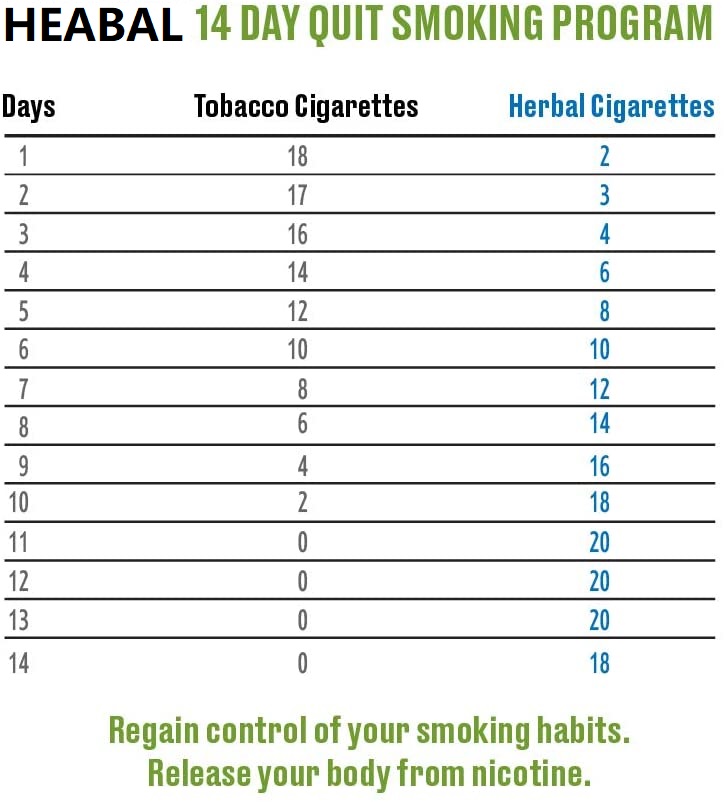Quitting nicotine and tobacco can be realized in one day or it can take time - after treating patients for years in the acupuncture clinic, I have analyzed what it takes to quit nicotine/smoking addiction. In the process, have identified three possible stages in helping you buffer nicotine intake:

Breaking the physiological dependence and chemical addiction in brain tissue.
The initial stage will catalyze the resetting of your brain tissue and its response to smoking. You will actually be smoking a burning cigarette that flicks, lights, and smokes like your tobacco cigarette. This should help break the nicotine barrier, that means as your brain receives the hand and oral fix, without the nicotine, your brain hopefully won't realize it is not getting the nicotine.
In stage ONE of the HEABAL PROCESS to quitting you don't want to stop smoking your own cigarettes. The strategy is to alternate with your own tobacco cigarettes. Alternate your tobacco cigarettes with HEABAL's. This should help your body start to adapt to the non-nicotine intake of smoke, and that is the plan - to get your brain to accept smoking a non-nicotine but identifiable replacement.
Buffering the nicotine withdrawals through HEABAL replacement, allowing for once addictive tissue to stabilize.
Depending on internal (brain tissue physiological break with nicotine) and external (life factors, stress triggers) variables, this stage can play out over weeks or months. It is a period of smoking but not ingesting nicotine, and therefore it accesses time to buffer the withdrawals and pull for nicotine -allowing for tissue stabilization.
Stage TWO is all about transitioning to smoking only HEABAL. This stage is characterized as total nicotine/tobacco replacement with HEABAL's. Smoke only HEABAL's during this stage, don't try to decrease number of cigarettes/packs smoked per a day, though. Unless your body/brain does it unconsciously.
Regeneration and repair of internal cellular structures (receptors), while mitigating the emotional pullback to smoke.
Although the body starts repairing damaged cells, receptor sites, and tissue soon after smoking cessation, it is only starting the process as repair initiation - not total repair and regeneration. Repair and regeneration take time. Know that the body gets new blood typically around every 120 days, and different cellular systems also repair and restore at different time intervals. With this knowledge, we can think of not only quitting cigarettes but repair and restoration from smoking as a process.
Stage three introduces the 'GLUCOSE PROTOCOL" to begin cigarette reduction. With the strategy in STAGE THREE, you will start to interfere with the brain's chemical/physiological pull to smoke. As you reduce the number of cigarettes you smoke, you must increase glucose intake. The brain runs on sugar, and complex sugars have enough sustaining sugar to help the brain re-modulate after years of addiction. Glucose sugar here mean foods like rice and potatoes. Without glucose intake during this completion state, you will find pullback to smoke because the brain will not have the resources to stabilize. Glucose will help your brain to operate at a optimum level with high output and function, helping it to cope with sympathetic (fight/flight) response triggers, and mitigate emotional return to smoking. Do you think this will make you gain weight? It shouldn't. This kind of sugar is fuel. It is not like soda or candy sugar that disrupts the endocrine system and allows for a slowdown in metabolism. Anyways, all this is drawn from clinical experience, so if you want to skip eating carbs to promote brain health, that is your choice.
HEABAL heat-not-burn product are not guaranteed to make you STOP SMOKING. They are only used to help buffer/downgrade your NICOTINE intake. Please know that we are not making any claims, any guarantees, any promises that using HEABALs will get you to stop smoking.
If you buy HEABAL with the intent to help with your nicotine addiction, please review the above steps in a process that may or may not help you.